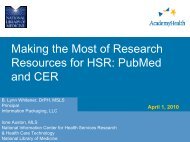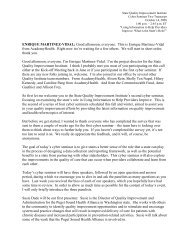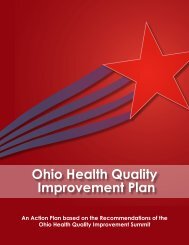The importance of reliability adjustment
The Importance of Reliability Adjustment
The Importance of Reliability Adjustment
Create successful ePaper yourself
Turn your PDF publications into a flip-book with our unique Google optimized e-Paper software.
Ranking hospitals on surgical mortality:<strong>The</strong> <strong>importance</strong> <strong>of</strong> <strong>reliability</strong> <strong>adjustment</strong>Justin B. Dimick, MD, MPHAssistant Pr<strong>of</strong>essor <strong>of</strong> SurgeryUniversity <strong>of</strong> MichiganAcademyHealth Annual Research MeetingJuly 28 th , 2009
Surgical quality measurementOutcomes – “Gold standard”• Patients, payers, providers agree theyare important• Better than other alternatives• Hospital volume, process measures• Strong track record in cardiac surgery– NY, PA, CA report cards
Big problems with small samples
A technique for dealingwith statistical “noise”• Reliability <strong>adjustment</strong>: Adjust point estimate <strong>of</strong> anoutcome for uncertainty by “shrinking” it back towards thepopulation average• Empirical Bayes techniques• An application <strong>of</strong> hierarchical modeling (estimatingrandom effects)• Increasingly applied in measuring performance ineducation and health care
Adjusting mortality rates for <strong>reliability</strong>:Reliabilityadjustedmortality rate= HospitalReliability + Overallmortalitymortality1-ReliabilityReliability=SignalSignal + Noise=Variance (µi)Variance (µi) + Variance (εij)/n6/29/2009What actually happens:For hospitals with large number <strong>of</strong> cases, moreweight is afforded to the hospital’s mortality rate andless to overall rateFor hospitals with few cases, less weight is affordedto the hospital’s mortality rate and more to the overallrate
Research question:Are hospital rankings based on <strong>reliability</strong>adjustedmortality better at predicting futureperformance?6/29/2009
• Data Sources:Data Source, Study Population, andPrimary OutcomeNational Medicare data (2003-2006)• Procedures:3 high-risk operations; focus <strong>of</strong> quality assessmentactivities; common to uncommon.– Coronary artery bypass– Abdominal aortic aneurysm repair– Pancreatic resection• Primary outcome:– Death within 30-days or prior to discharge6/29/2009
Analytic approach:• Risk-<strong>adjustment</strong>:– Patient age, gender, race, admission acuity,coexisting diseases using Elixhauser index• Reliability-<strong>adjustment</strong>:– Hierarchical modeling to estimate randomeffects for each hospital (xtmelogit inSTATA)– Estimated using empirical Bayes techniques6/29/2009
Analytic approach:2003-04 2005-061Risk-adjustedmortalityNOT adjustedfor <strong>reliability</strong>Risk-adjustedmortalityAdjusted for<strong>reliability</strong>Rank hospitals,create 5 groups(quintiles)23451234Risk-adjustedmortalityRisk-adjustedmortality56/29/2009
Number <strong>of</strong> patients and hospitalcaseloads, 2003-04OperationMedicare casesCoronary artery bypass 303,132 267 (256)Hospital caseloads,mean (SD)Abdominal aortic aneurysmrepair70,863 33 (49)Pancreatic resection 6,192 6 (13)
Impact <strong>of</strong> <strong>reliability</strong> <strong>adjustment</strong>Risk-adjustedMortality (%)0 10 20 30 40 50 60 70 80 90 100Pancreatic ResectionBefore <strong>reliability</strong> <strong>adjustment</strong>After <strong>reliability</strong> <strong>adjustment</strong>Risk-adjusted mortality rates20 randomly sampled hospitals
Are <strong>reliability</strong> adjusted mortality rates better atpredicting future performance?Pancreatic cancer resection12.0%Riskadjustedmortality, %(2005-06)10.0%8.0%6.0%7.6%5.9%10.5%4.5%7.4%10.8%9.0%4.0%3.4%3.2%2.7%2.0%0.0%1 2 3 4 5 1 2 3 4 5Not adjusted for reliablityAdjusted for <strong>reliability</strong>Hospital Rankings (Quintiles)(2003-04)
Are <strong>reliability</strong> adjusted mortality rates better atpredicting future performance?6.0%5.0%Abdominal aortic aneurysm repair4.9% 4.9%Risk-adjustedmortality(2005-06)4.0%3.0%4.0%3.1%3.4%3.7%3.2%3.3%3.9%4.0%2.0%1.0%0.0%1 2 3 4 5 1 2 3 4 5Not adjusted for reliablityAdjusted for <strong>reliability</strong>Quintiles <strong>of</strong> Hospital Rankings(2003-04)
Are <strong>reliability</strong> adjusted mortality rates better atpredicting future performance?Risk-adjusted-mortality(2005-06)6.0%5.0%4.0%3.0%Coronary artery bypass5.3% 5.4%4.5% 4.4%4.0% 4.0%3.4% 3.3%3.0% 3.0%2.0%1.0%0.0%1 2 3 4 5 1 2 3 4 5Not adjusted for reliablityAdjusted for <strong>reliability</strong>Quintiles <strong>of</strong> Hospital Rankings(2003-04)
Summary:• Reliability adjusted mortality betterforecasts future performance for high-risksurgery• Most important for uncommon operations– Pancreatectomy > AAA >> CABG6/29/2009
Implications:• Reliability <strong>adjustment</strong> should become thestandard for all efforts aimed at tracking surgicaloutcomes• Applications:– Massachusetts cardiac surgery report card– Blueprint for a new ACS-NSQIP– <strong>The</strong> Leapfrog Group’s composite measure6/29/2009
AcknowledgementsDouglas Staiger, PhDCollaborator, Dartmouth Medical School6/29/2009










